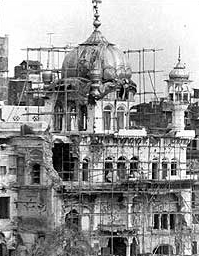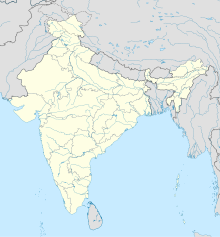
Back عملية بلو ستار Arabic Mavi ulduz əməliyyatı Azerbaijani অপারেশন ব্লু স্টার Bengali/Bangla Operation Blue Star German Operación Estrella Azul Spanish Operaatio Sininen tähti Finnish Opération Blue Star French ऑपरेशन ब्लू स्टार Hindi Operasi Bintang Biru ID Operazione Blue Star Italian
This article's tone or style may not reflect the encyclopedic tone used on Wikipedia. (September 2024) |
| Operation Blue Star | |||||||
|---|---|---|---|---|---|---|---|
| Part of the Khalistan movement, the Dharam Yudh Morcha, and the Insurgency in Punjab | |||||||
 Akal Takht being repaired by the Indian government after the offensive; it was later pulled down and rebuilt by the Indian Sikh community.[5][6] | |||||||
| |||||||
| Parties to the civil conflict | |||||||
|
|
| ||||||
| Commanders and leaders | |||||||
| Strength | |||||||
| 80–200 militants[12]: 35 [13][14][15]: 53, 72 | ||||||
| Casualties and losses | |||||||
|
Government numbers: 492+ killed (including Sikh pilgrims)[21] (see Casualties) | ||||||
| 5,000–10,000 civilians killed during the operation[22][23][24][15]: 151 | |||||||
Location of the operation within the Indian state of Punjab Location of the operation within India | |||||||
Operation Blue Star was a military operation by the Indian Armed Forces conducted between 1 and 10 June 1984 to remove Jarnail Singh Bhindranwale and other Sikh militants from the Golden Temple (Harmandir Sahib), a holy site of Sikhism, and its adjacent buildings.
A long-standing movement advocating for greater political rights for the Sikh community had previously existed in the Indian state of Punjab, and in 1973, Sikh activists presented the Indian government with the Anandpur Sahib Resolution, a list of demands for greater autonomy for Punjab. The resolution was rejected by the Indian government. In July 1982, Harchand Singh Longowal, the president of the Sikh political party Shiromani Akali Dal, invited Bhindranwale, who was wanted by authorities, to take up residence in the Golden Temple to evade arrest.[25]: 332 [26] Bhindranwale had organized killer squads to eliminate supposed enemies of Sikhism.[27] From the Harmandir Sahib complex, Bhindranwale orchestrated militants to kill hundreds of Hindus, and used terrorism to evoke fear among Hindus, hoping to incite their mass flight from Punjab.[28][29][30] On 1 June 1984, after negotiations with the militants failed, Indian prime minister Indira Gandhi ordered the army to launch Operation Blue Star in haste, attacking the Golden Temple and scores of other Sikh temples and sites across Punjab which included killing civilians and devotees too.[31]
The military underestimated the firepower possessed by the Sikh militants, whose armaments included Chinese-made rocket-propelled grenade launchers and ammunition with armour-piercing capabilities. Hoping to avoid damage to the holy site, Indian forces unsuccessfully assaulted the temple using light weaponry and quickly resorted to using heavy weapons, including tanks, helicopters and artillery to dislodge the well-fortified Sikh militants. Combat devolved into protracted urban warfare, with the Indian forces committing significant forces to slowly gain ground. Eventually, the Sikh militants ran out of most of their ammunition on 6 June, and by 10 June fighting had largely ceased, with the Indian forces in control of the complex. The Indian government attributed high civilian casualties to Sikh militants using pilgrims trapped inside the temple as human shields.[32] However, Indian forces were aware that civilians were present inside, and the operation began on a Sikh religious day, the martyrdom day of Guru Arjan Dev, when many worshippers would be present. Many civilians were subject to extrajudicial killings by the military during the operation.[33][34][35][36][37]
The military action in the temple complex was criticized by Sikhs worldwide, who interpreted it as an assault on the Sikh religion and the entire Sikh community.[38] Five months after the operation, on 31 October 1984, Indira Gandhi was assassinated in retaliation by two Sikhs, Satwant Singh and Beant Singh.[26] Her party, the Indian National Congress, utilized public outcry over her death, leading to the 1984 anti-Sikh riots led by Congress workers and angered mobs, which resulted in the deaths of thousands of Sikh civilians.[39] Despite accomplishing its stated objectives, the operation has been described as "disastrous" for the Indian military and state.[7][40] It greatly exacerbated tensions between the Indian government and the Sikh community, many of whom had been demanding a separate state. Meanwhile, the anti-Sikh riots of 1984 turned a series of police operations into widespread sectarian violence. The brutality of the operation and high civilian casualties spawned an insurgency in Punjab, which would be waged by Sikh militants for over a decade. The operation has been used as a case study highlighting the importance of respecting religious and cultural sensitivity prior to launching military operations. The complex would later be raided twice more as part of Operation Black Thunder I and II, with both operations having little to no civilian casualties or damage to the Temple despite larger amounts of militants than Operation Blue Star.[7]
- ^ Jerryson, Michael (15 July 2020). Religious Violence Today: Faith and Conflict in the Modern World. ABC-CLIO. ISBN 978-1-4408-5991-5.
- ^ Brar, K. S. (2014). Operation Blue Star: The True Story. UBS Publishers' Distributors. ISBN 978-8174760685. OCLC 1181348326.
- ^ Dogra, Cander Suta (10 June 2013). "Operation Blue Star – the Untold Story". The Hindu.
- ^ Keppley Mahmood, Cynthia (2011). Fighting for Faith and Nation: Dialogues with Sikh Defenders. University of Pennsylvania Press. 91, 21, 200, 77, 19. ISBN 978-0812200171.
- ^ Tatla, Darshan Singh (1993). The politics of homeland: a study of the ethnic linkages and political mobilisation amongst Sikhs in Britain and North America (Thesis). University of Warwick. p. 133.
- ^ "Architecture & History". akaltakhtsahib.com. Archived from the original on 13 October 2017. Retrieved 10 October 2017.
- ^ a b c d Hassner, Ron E. (2006). "Fighting insurgency on sacred ground". The Washington Quarterly. 29 (2). Informa UK: 149–166. doi:10.1162/wash.2006.29.2.149. ISSN 0163-660X. S2CID 110929395.
- ^ "Temple Raid: Army's Order was Restraint". The New York Times. 15 June 1984. Archived from the original on 13 November 2012. Retrieved 6 February 2012.
- ^ Cite error: The named reference
ReferenceB22was invoked but never defined (see the help page). - ^ Rikhye, Ravi (1990). The Militarization of Mother India. Chanakya. p. 134. ISBN 978-81-7001-060-9.
- ^ Tully, Mark; Jacob, Satish (1985). Amritsar, Mrs. Gandhi's last battle. Calcutta: Rupa & Co. p. 163 – via Internet Archive.
- ^ Karim, Afsir (1991). Counter Terrorism, the Pakistan Factor. Lancer. pp. 33–36. ISBN 978-8170621270.
- ^ Cite error: The named reference
Punjab2003was invoked but never defined (see the help page). - ^ Tarkunde et al. 1985, p. 65.
- ^ a b c d Jaijee, Inderjit Singh (1999). Politics of Genocide: Punjab, 1984–1998. Ajanta. ISBN 978-8120204157. OCLC 42752917.
- ^ Cite error: The named reference
WhitePaper1984was invoked but never defined (see the help page). - ^ "The Official Home Page of the Indian Army". Archived from the original on 27 May 2013. Retrieved 10 October 2017.
- ^ "What happened during 1984 Operation Blue Star?". India Today. 6 June 2018. Retrieved 12 September 2019.
Official reports put the number of deaths among the Indian army near about 83 and they put the number of civilian deaths at 493, though independent estimates ran much higher.
- ^ Chima, Jugdep S. (2008). The Sikh Separatist Insurgency in India: Political Leadership and Ethnonationalist Movements. Sage Publishing India. pp. 114–. ISBN 978-9351509530.
- ^ "Army reveals startling facts on Bluestar". Tribune India. 30 May 1984. Retrieved 9 August 2009.
- ^ "The untold story before Operation Bluestar". India Today. 6 June 2019. Retrieved 10 June 2021.
- ^ Grewal, J. S. (1998). The Sikhs of the Punjab. The New Cambridge History of India. Vol. II.3 (revised ed.). Cambridge: Cambridge University Press. pp. 205–241. ISBN 978-1316025338. Retrieved 16 April 2020.
- ^ Karim 1991, p. 35.
- ^ "What happened during 1984 Operation Blue Star?". India Today. 6 June 2018. Retrieved 9 February 2021.
Official reports put the number of deaths among the Indian army at 83 and the number of civilian deaths at 492, though independent estimates ran much higher.
- ^ Singh, Khushwant (1984). A History of the Sikhs. Vol. II: 1839–1974. Princeton University Press; Oxford University Press. ISBN 978-0691030227. OCLC 769219183.
- ^ a b "Operation Blue Star: India's first tryst with militant extremism". DNA India. 5 November 2016. Archived from the original on 3 November 2017. Retrieved 29 October 2017.
- ^ Jetly, Rajshree (2008). "The Khalistan Movement in India: The Interplay of Politics and State Power". International Review of Modern Sociology. 34 (1): 61–75. ISSN 0973-2047. JSTOR 41421658.
He also organised killer squads in each village to eliminate the 'enemies' of the Sikh faith, thereby increasing his visibility and reach across the state
- ^ Bonner, Arthur (20 February 1990). Averting the Apocalypse: Social Movements in India Today. Duke University Press. p. 381. ISBN 978-0-8223-1048-8.
Bhindranwale attracted a coterie of terrorists who robbed banks and killed hundreds of Hindus and those dubbed Sikh apostates. [...] However, when the terrorists began random killings of Hindus, hoping to precipitate mass flight, thereby creating a de facto Khalistan, Bhindranwale could no longer count on behind the scenes government support and moved to the sanctuary of the Golden Temple.
- ^ Ganguly, Sumit; Mukherji, Rahul (1 August 2011). India Since 1980. Cambridge University Press. p. 152. ISBN 978-1-139-49866-1.
Not surprisingly, these rampant attacks on Hindus, orchestrated by Bhindranwale from the Golden Temple in Amritsar, the holiest of Sikh shrines, led to a Hindu backlash
- ^ Ganguly, Sumit; Fidler, David P. (7 May 2009). India and Counterinsurgency: Lessons Learned. Routledge. ISBN 978-1-134-00808-7.
Bhindranwale used terrorism to frighten and intimidate Hindus
- ^ Wolpert, Stanley A., ed. (2009). "India". Encyclopædia Britannica.
- ^ Cite error: The named reference
Kiss_Khalistanwas invoked but never defined (see the help page). - ^ Tarkunde et al. 1985, pp. 58–59.
- ^ Gurdarshan Singh Dhillon (1996). Truth About Punjab: SGPC White Paper. Amritsar: Shiromani Gurdwara Parbandhak Committee. p. 245. GGKEY:5BNR2KUYRHJ.
- ^ Kaur, Amarjit (2004). The Punjab Story. Lotus. ISBN 978-8174369123.
- ^ Tarkunde et al. 1985, p. 70.
- ^ Tarkunde et al. 1985, p. 76.
- ^ Westerlund, David (1996). Questioning The Secular State: The Worldwide Resurgence of Religion in Politics. C. Hurst & Co. p. 1276. ISBN 978-1850652410.
- ^ Joseph, Paul (2016). The Sage Encyclopedia of War: Social Science Perspectives. SAGE Publications. p. 433. ISBN 978-1483359885.
around 17,000 Sikhs were burned alive or killed
- ^ Anderson, L. D. (2013). Federal Solutions to Ethnic Problems: Accommodating Diversity. Exeter studies in ethno politics. Routledge. p. 182. ISBN 978-0-415-78161-9. Retrieved 14 August 2023.

